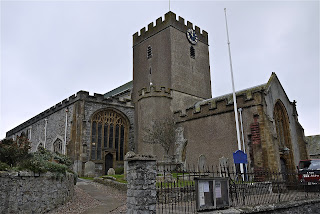Abbotstone
The weather forecast strongly indicated that this would be the one non-rainy day this week so I thought I had better get our for a walk. I picked up the route a mile south of Brown Candover (2 miles along the Wayfarer's Walk) and headed uphill along a farm track. There was a chance of a photo looking towards Northington church, but a black cloud came overhead at just the wrong moment.
I realised that I was now following a section of the Three Castles Path (Upper Wield to Abbotstone), which we did on a nice sunny day in April 2009. This has the Northington church photo and some brief information about it, so nothing was lost.
The path carried on along past Swarraton Farm to cross the B3046 and go along the edge of Abbotstone Down. The OS map also shows the track as being also part of the Oxdrove Way. It seems clear that one hedgerow has at some time been removed and this is now a field-edge path. You pass a derelict concrete structure, possibly intended as a farm house and approach Abbotstone Farm.
Abbotstone is a very elusive place. The map shows the site of a medieval village, but now thee are just a few scattered houses. As you approach the only road junction the slopes opposite seem white: surely not localised snow? Heavy fertiliser maybe?
It is only when you get right up close that the odd white strips are revealed as sheets of clear polythene spread flat over the earth, no doubt to aid the germination of seeds.
You cross the pretty, but seemingly unnamed stream, to reach the signpost which now marks Abbotstone. I decided to call a halt here.
Conditions: cloudy with some sunshine, a few hints of rain
Map: Explorer 132 (Winchester)
Forward distance: 3.5 miles; distance now traveled 35.5 miles. Almost half way!
Rating: three stars. Good to get out, but fairly basic.
Sightings
I decided to make a real effort with my bird observation and was rewarded with a reasonably rich haul: Buzzards, a Red kite, a flock of Yellowhammers, a Greater Spotted Woodpecker, Skylarks, Meadow Pipits, Wrens, a Kestrel, Canada Geese, House Martins - not counting garden birds, crows, pigeons. Also loads of Pheasants and Red Legged Partridge.
Flower of the day
Ground Ivy. It looks more interesting and exotic photographed at ground level.









































